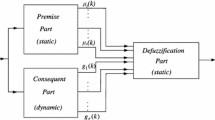Abstract
In this work, a dynamic neurofuzzy system for forecasting outgoing telephone calls in a University Campus is proposed. The system comprises modified Takagi–Sugeno–Kang fuzzy rules, where the rules’ consequent parts are small neural networks with unit internal recurrence. The characteristics of the proposed forecaster, which is entitled recurrent neurofuzzy forecaster, are depicted via a comparative analysis with a series of well-known forecasting models.



Similar content being viewed by others
References
Hilas CS, Goudos SK, Sahalos JN (2006) Seasonal decomposition and forecasting of telecommunication data: a comparative case study. Technol Forecast Soc Chang 73:495–509
Madden G, Joachim T (2007) Forecasting telecommunications data with linear models. Telecommun Policy 31:31–44
Makridakis SG, Wheelwright SC, McGee VE (1998) Forecasting: methods and applications, 3rd edn. Wiley, New York
Holt CE (1957) Forecasting Trends and Seasonals by Exponentially Weighted Moving Averages. ONR Memorandum 52, Carnegie Institute of Technology, Pittsburg, USA. (Reprinted in 2004: Int J Forecast 20:5–10)
Winters PR (1960) Forecasting sales by exponentially weighted moving averages. Manage Sci 6:324–342
Gardner ES Jr (1985) Exponential smoothing: the state of the art. J Forecast 4:1–28
Box GEP, Jenkins GM (1976) Time series analysis: forecasting and control, 2nd edn. Holden-Day, San Francisco
Takagi T, Sugeno M (1985) Fuzzy identification of systems and its applications. IEEE Trans Syst Man Cybern 15:116–132
Lin C-J, Chin C–C (2004) Prediction and identification using wavelet-based recurrent fuzzy neural networks. IEEE Trans Syst Man Cybern Part B 34:2144–2154
Hsu Y-C, Lin S-F (2009) Reinforcement group cooperation-based symbiotic evolution for recurrent wavelet-based neurofuzzy systems. Neurocomputing 72:2418–2432
Gonzalez-Olvera MA, Tang Y (2010) Black-box identification of a class of nonlinear systems by a recurrent neurofuzzy network. IEEE Trans Neural Netw 21:672–679
Tsoi AC, Back AD (1994) Locally recurrent globally feedforward networks: a critical review of architectures. IEEE Trans Neural Netw 5:229–239
Hsu Y-L, Wang J-S (2009) A wiener-type recurrent neural network and its control strategy for nonlinear dynamic applications. J Process Control 19:942–953
Vairappan C, Tamura H, Gao S, Tang Z (2009) Batch type local search-based adaptive neuro-fuzzy inference system (ANFIS) with self-feedbacks for time-series prediction. Neurocomputing 72:1870–1877
Jassar S, Liao Z, Zhao L (2011) A recurrent neuro-fuzzy system and its application in inferential sensing. Appl Soft Comput 11:2935–2945
Lin C-J, Chen C-H (2005) Identification and prediction using recurrent compensatory neuro-fuzzy systems. Fuzzy Sets Syst 150:307–330
Li C, Cheng K-H (2007) Recurrent neuro-fuzzy hybrid-learning approach to accurate system modeling. Fuzzy Sets Syst 17:479–491
Lee C-H, Chiu M-H (2009) Recurrent neuro fuzzy control design for tracking of mobile robots via hybrid algorithm. Expert Syst Appl 36:8993–8999
Lee C-H, Chang F-K (2008) Recurrent fuzzy neural controller design for nonlinear systems using electromagnetism-like algorithm. Far East J Exp Theor Artif Intell 1:5–22
Lee C-H, Lee Y-C (2012) Nonlinear systems design by a novel fuzzy neural system via hybridization of electromagnetism-like mechanism and particle swarm optimisation algorithms. Inf Sci 186:59–72
Juang C-F (2004) A hybrid of genetic algorithm and particle swarm optimization for recurrent network design. IEEE Trans Syst Man Cybern Part B 34:997–1006
Juang C-F, Lin Y–Y, Tu C–C (2010) A recurrent self-evolving fuzzy neural network with local feedbacks and its application to dynamic system processing. Fuzzy Sets Syst 161:2552–2568
Theocharis JB (2006) A high-order recurrent neuro-fuzzy system with internal dynamics: application to the adaptive noise cancellation. Fuzzy Sets Syst 157:471–500
Mastorocostas PA, Theocharis JB (2002) A recurrent fuzzy neural model for dynamic system identification. IEEE Trans Syst Man Cybern Part B 32:176–190
Tao J, Wang N, Wang X (2007) Genetic algorithm based recurrent fuzzy neural network modeling of chemical processes. J Univ Comput Sci 13:1332–1343
Stavrakoudis DG, Theocharis JB (2007) Pipelined recurrent fuzzy networks for nonlinear adaptive speech prediction. IEEE Trans Syst Man Cybern Part B 37:1305–1320
Barbounis TG, Theocharis JB (2006) Locally recurrent neural networks for long-term wind speed and power prediction. Neurocomputing 69:466–496
Riedmiller M, Braun H (1993) A direct adaptive method for faster backpropagation learning: the RPROP algorithm. In: Proceedings of IEEE International joint conference on neural networks, pp 586–591
Werbos PJ (1974) Beyond regression: new tools for prediction and analysis in the behavioral sciences. Ph.D. Thesis, Harvard University
Piche SW (1994) Steepest descent algorithms for neural network controllers and filters. IEEE Trans Neural Netw 5:198–212
ITU-T ICTeye Reports (2010) Available online: http://www.itu.int/ITU-D/ICTEYE/Reports.aspx [last accessed: December 2010]
Fildes R, Nikolopoulos K, Crone S, Syntetos A (2008) Forecasting and operational research: a review. J Oper Res Soc 59:1150–1172
Acknowledgments
The authors wish to acknowledge financial support provided by the Research Committee of Technological Educational Institute of Serres under grant +SAT/IC/15062011-66/11.
Author information
Authors and Affiliations
Corresponding author
Rights and permissions
About this article
Cite this article
Mastorocostas, P.A., Hilas, C.S. ReNFFor: a recurrent neurofuzzy forecaster for telecommunications data. Neural Comput & Applic 22, 1727–1734 (2013). https://doi.org/10.1007/s00521-012-0840-6
Received:
Accepted:
Published:
Issue Date:
DOI: https://doi.org/10.1007/s00521-012-0840-6




